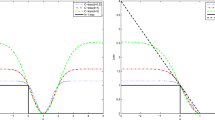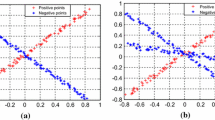Abstract
This paper presents a L1-norm loss-based projection twin support vector machine (L1LPTSVM) for binary classification. In the pair of optimization problems of L1LPTSVM, L1-norm-based losses are considered for two classes, which leads to two different dual problems with projection twin support vector machine (PTSVM). Compared with PTSVM, L1LPTSVM has two main advantages: first, the dual problems of L1LPTSVM avoid the complex calculation of inverse matrices in the training process, indicating that L1LPTSVM can be solved efficiently using some SVM-type training algorithms. Second, similar to the traditional SVM, L1LPTSVM has an unified form in the linear and nonlinear cases. In addition, a density-dependent quantization scheme for sparse representation is used as the data preprocessing unit attached to L1LPTSVM, which makes L1LPTSVM be more suitable for large-scale problems. Extensive experimental results on several artificial and benchmark data sets show the effectiveness of the proposed method.


Similar content being viewed by others
References
Burges C (1998) A tutorial on support vector machines for pattern recognition. Data Min Knowl Discov 2:121–167
Cevikalp H, Franc V (2017) Large-scale robust transductive support vector machines. Neurocomputing 235:199–209
Chen X, Yang J, Ye Q, Liang J (2011) Recursive projection twin support vector machine via within-class variance minimization. Pattern Recognit 44:2643–2655
Chen S, Wu X, Yin H (2017) A novel projection twin support vector machine for binary classification. Soft Comput 10:10. https://doi.org/10.1007/s00500-017-2974-z
Ding S, Hua X (2014) Recursive least squares projection twin support vector machines. Neurocomputing 130:3–9
Ding S, Zhang X, An Y, Xue Y (2017a) Weighted linear loss multiple birth support vector machine based on information granulation for multi-classification. Pattern Recognit 67:32–46
Ding S, An Y, Zhang X, Wu F, Xue Y (2017b) Wavelet twin support vector machines based on glowworm swarm optimization. Neurocomputing 225:157–163
Gu Z, Zhang Z, Sun J, Li B (2017) Robust image recognition by L1-norm twin-projection support vector machine. Neurocomputing 223:1–11
Hua X, Ding S (2015) Weighted least squares projection twin support vector machines with local information. Neurocomputing 160:228–237
Jayadeva R, Khemchandai R, Chandra S (2007) Twin support vector machines for pattern classification. IEEE Trans Pattern Anal 29:905–910
Kumar MA, Gopal M (2009) Least squares twin support vector machines for pattern classification. Expert Syst Appl 36:7535–7543
Mangasarian OL (1994) Nonlinear programming. SIAM, Philadelphia
Mangasarian OL, Musicant DR (1999) Successive overrelaxation for support vector machines. IEEE Trans Neural Netw 10:1032–1037
Nan S, Sun L, Chen B, Lin Z, Toh K (2017) Density-dependent quantized least squares support vector machine for large data sets. IEEE Trans Neural Netw Learn Syst 28:94–105
Nedaie A, Najafi AA (2016) Polar support vector machine: Single and multiple outputs. Neurocomputing 171:118–126
Peng X, Chen D (2018) PTSVRs: regression models via projection twin support vector machine. Inf Sci 435:1–14
Peng X, Shen J (2017) A twin-hyperspheres support vector machine with automatic variable weights for data classification. Inf Sci 417:216–235
Peng X, Xu D, Kong L, Chen D (2016) L1-norm loss based twin support vector machine for data recognition. Inf Sci 340–341:86–103
Peng X, Rafferty K, Ferguson S (2017) A fast algorithm for sparse support vector machines for mobile computing applications. Neurocomputing 230:160–172
Shao Y, Deng N, Yang Z (2012) Least squares recursive projection twin support vector machine for classification. Pattern Recognit 45:2299–2307
Shao Y, Wang Z, Chen W, Deng N (2013) A regularization for the projection twin support vector machines. Knowl Based Syst 37:203–210
Shao YH, Chen WJ, Deng NY (2014) Nonparallel hyperplane support vector machine for binary classification problems. Inf Sci 263:22–35
Tuan Y, Qi Z, Ju X, Shi Y, Liu X (2014) Nonparallel support vector machines for pattern classification. IEEE Trans Cybern 44:1067–1079
Vapnik VN (1995) The natural of statistical learning theory. Springer, New York
Vapnik VN (1998) Statistical learning theory. Wiley, New York
Wang H, Zhou Z (2017) An improved rough margin-based v-twin bounded support vector machine. Knowl Based Syst 128:125–138
Xie X, Sun S (2017) PAC-Bayes bounds for twin support vector machines. Neurocomputing 234:137–143
Xu Y, Yang Z, Pan X (2017) A novel twin support-vector machine with pinball loss. IEEE Trans Neural Netw Learn Syst 2:359–370
Yan H, Ye Q, Zhang T, Yu DJ, Yuan X, Xu Y, Fu L (2018) Least squares twin bounded support vector machines based on L1-norm distance metric for classification. Pattern Recognit 74:434–447
Ye Q, Zhao C, Ye N, Chen Y (2010) Multi-weight vector projection support vector machines. Pattern Recognit Lett 31:2006–2011
Yi P, Song A, Guo J, Wang R (2017) Regularization feature selection projection twin support vector machine via exterior penalty. Neural Comput Appl 28:683–697
Acknowledgements
The authors are very grateful to the National Natural Science Foundation of China (No. 61379101), the Jiangsu Natural Science Foundation of China (No. BK20151299) and the Jiangsu Provincial Science and Technology Support Project of China (Nos. BY2016065-01, BY2016065-05) for support.
Author information
Authors and Affiliations
Corresponding author
Ethics declarations
Conflict of interest
The authors declare that they have no conflict of interest.
Additional information
Communicated by A. Di Nola.
Publisher’s Note
Springer Nature remains neutral with regard to jurisdictional claims in published maps and institutional affiliations.
Rights and permissions
About this article
Cite this article
Hua, X., Xu, S., Gao, J. et al. L1-norm loss-based projection twin support vector machine for binary classification. Soft Comput 23, 10649–10659 (2019). https://doi.org/10.1007/s00500-019-04002-6
Published:
Issue Date:
DOI: https://doi.org/10.1007/s00500-019-04002-6




